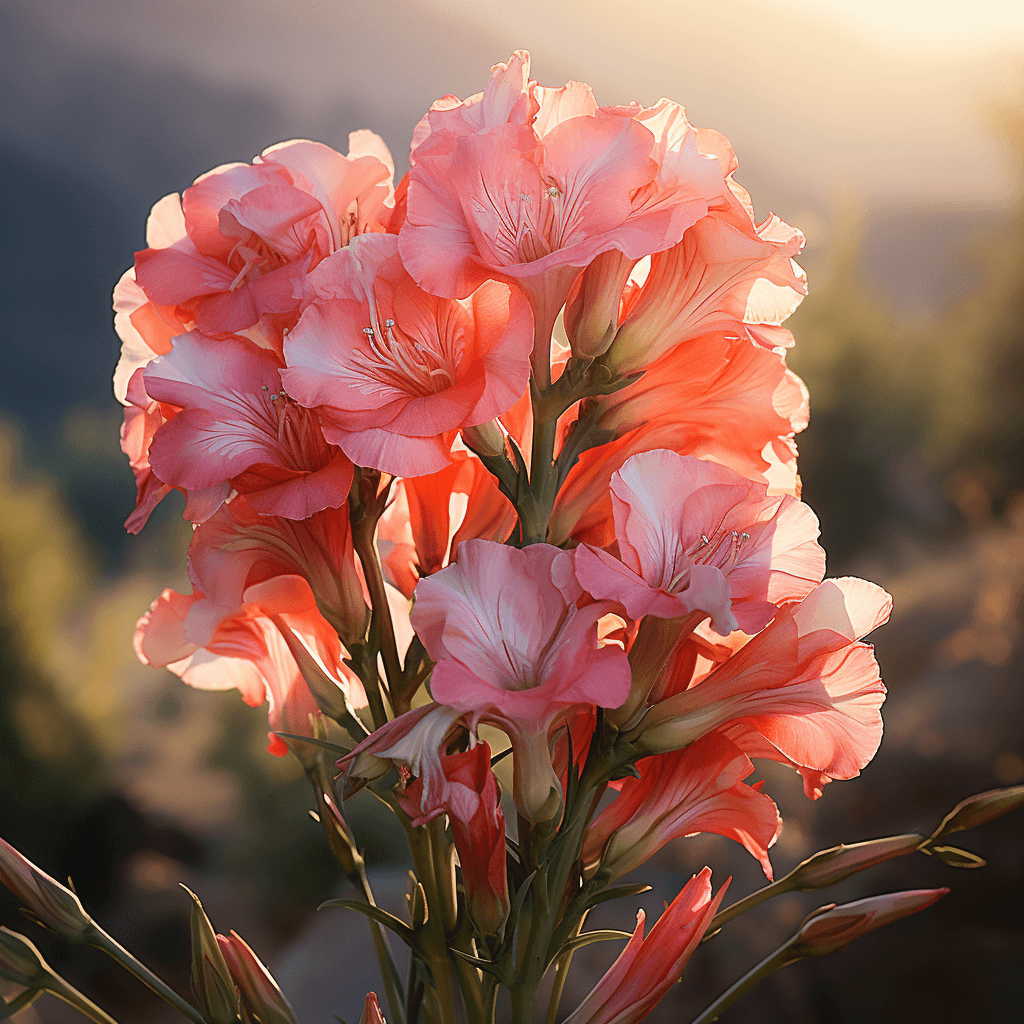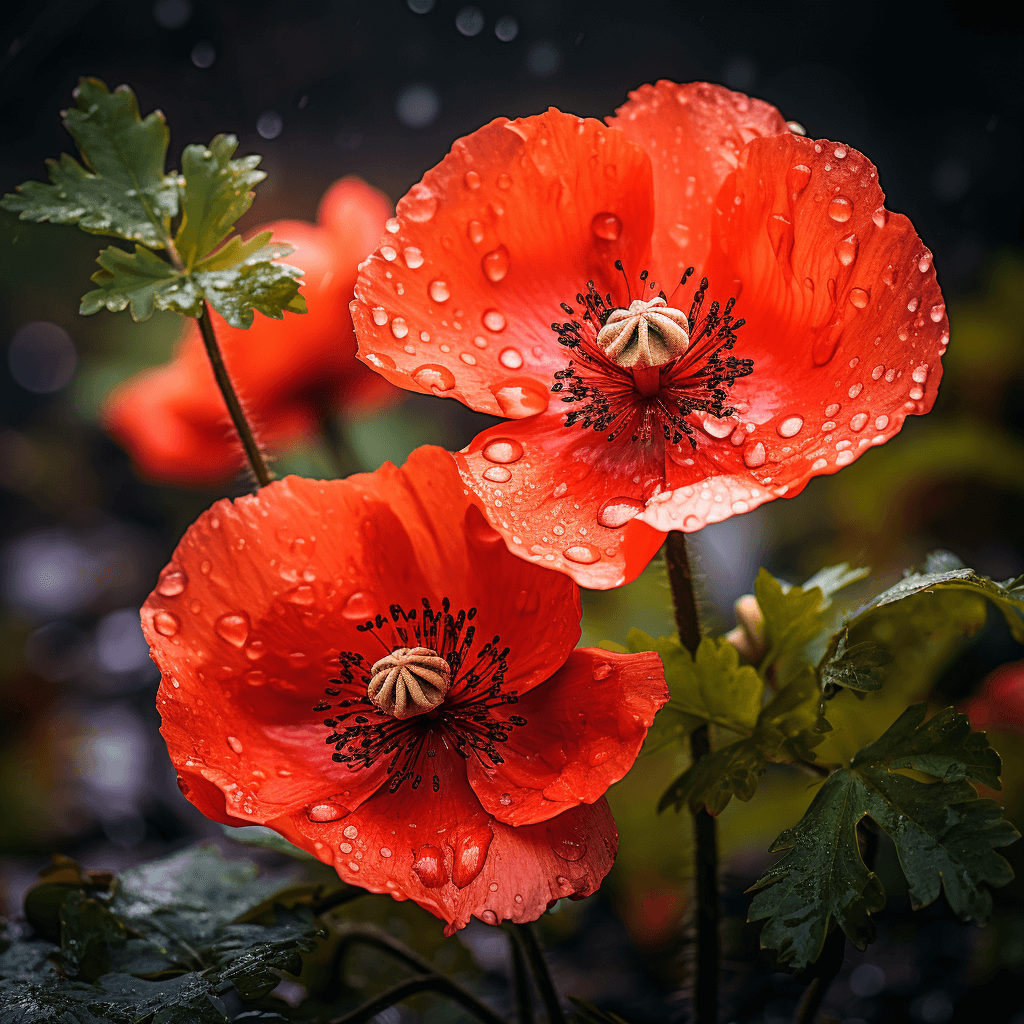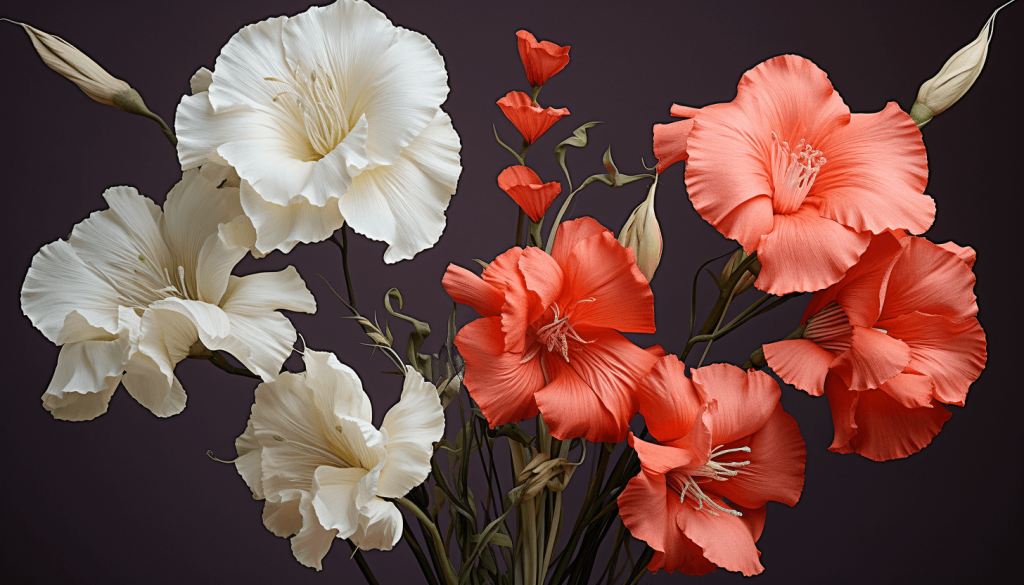As the warmth of summer reaches its zenith, August graces us with two captivating blooms: the Gladiolus and the Poppy. The Gladiolus, often referred to as the “Sword Lily,” stands tall and proud, symbolizing strength, integrity, and passion. In contrast, the delicate Poppy, with its paper-thin petals, whispers tales of dreams, remembrance, and the ephemeral nature of life. Both flowers, with their distinct characteristics and stories, beautifully encapsulate the spirit of August—a month of abundance, reflection, and transitions.
Every month is graced with a unique birth flower, offering a natural and symbolic representation of its character and essence. Just as gemstones have been cherished for their association with birth months, flowers too have been celebrated for the sentiments they encapsulate. This age-old tradition provides a beautiful way to understand and connect with the changing seasons and the qualities they usher in. For those keen on immersing themselves further in the fascinating lore of birth flowers, our detailed birth flowers article awaits your exploration. Dive with us into the enchanting world of these flowers, exploring their rich histories, varied meanings, and cultural significance.
Symbolism of the Gladiolus: Delving into the Meanings of August’s Majestic Spear

The Gladiolus, with its striking height and vibrant blossoms, is more than just a visual delight. Its name, derived from the Latin word ‘gladius,’ means ‘sword,’ and true to its name, the Gladiolus carries with it symbols of strength and moral integrity. But there’s more to this flower than meets the eye.
- Strength and Victory: Historically, Gladioli were associated with gladiators. The flower’s resemblance to a sword was seen as a symbol of strength, victory, and pride. It’s no wonder that they are often gifted to athletes and those who have overcome significant challenges.
- Moral Integrity: Beyond physical strength, the Gladiolus also represents a strong character, faithfulness, and honor. Gifting a bouquet of Gladioli can be a gesture of admiration for someone’s moral compass and unwavering principles.
- Passion and Love: The vibrant hues of the Gladiolus, especially the reds and pinks, symbolize a deep passion and love. They are often given as tokens of affection, representing the intensity and depth of one’s feelings.
- Remembrance: In some cultures, Gladioli are planted on the graves of loved ones as a tribute and a symbol of remembrance, ensuring that the memories of the departed remain alive and vibrant.
Whether standing tall in a garden or gracing a vase indoors, the Gladiolus speaks a language of dignity, honor, and deep emotions, making it a fitting emblem for the sun-soaked days of August.
Historical Significance of the Gladiolus: A Journey Through Time with the “Sword Lily”
The Gladiolus, often referred to as the “Sword Lily” due to its sword-shaped leaves, boasts a rich history that intertwines with various cultures and eras. Its presence has been felt from the sands of Africa to the ancient arenas of Rome, and its significance has evolved over time.
| Time Period | Significance |
|---|---|
| Ancient Africa | The Gladiolus is native to Africa, where it was used for its medicinal properties. The bulbs of the plant were ground into a powder and used as a poultice for wounds or mixed with goat’s milk to treat ailments. |
| Roman Era | During the Roman times, Gladioli were associated with gladiators. The flowers were often presented to victorious gladiators, symbolizing victory and pride in the arena. |
| Victorian Era | In the language of flowers, popularized during the Victorian era, the Gladiolus conveyed messages of strength, moral integrity, and infatuation. It was a popular choice in bouquets meant to pierce the heart of a beloved. |
| Modern Day | Today, the Gladiolus stands as a symbol of August birthdays and 40th wedding anniversaries. Its vibrant colors and towering presence make it a favorite in summer gardens and floral arrangements. |
From its humble beginnings in the wild terrains of Africa to its revered status in modern gardens, the Gladiolus has journeyed through time, leaving an indelible mark on history and the hearts of flower enthusiasts.
Astrological Insights on the Gladiolus: How August’s Dominant Flower Resonates with the Zodiac
August, a month ruled by the sun sign Leo, is synonymous with warmth, vitality, and leadership. The Gladiolus, with its towering presence and vibrant hues, perfectly mirrors these Leo traits, making it a fitting emblem for those born under this fiery sign.
- Leo and the Gladiolus: Both Leo and the Gladiolus stand out in any crowd. Just as Leo is known for its charismatic and dominant nature, the Gladiolus, with its tall spikes of flowers, demands attention wherever it blooms.
- Vitality and Strength: Leo, ruled by the Sun, is a sign of life force and energy. Similarly, the Gladiolus represents strength and integrity, echoing the robust nature of this zodiac sign.
- Passion and Heart: Leos are known for their big hearts and passionate nature. The deep red hues of certain Gladiolus varieties resonate with this intense emotion and ardor.
- Generosity and Infatuation: Just as Leos are generous with their love and resources, the Gladiolus symbolizes a generosity of spirit, offering its beauty freely. It’s also a flower of infatuation, making it a symbol of the overwhelming feelings often associated with those ruled by the Sun.
Furthermore, the Gladiolus also finds resonance with the planet Mars, which is associated with drive, determination, and desires. This connection further amplifies the flower’s association with strength and passion.
In the cosmic dance of the stars, the Gladiolus finds its rhythm and resonance, making it not just a flower of beauty but also of profound astrological significance.
Gladiolus Colors & Their Meanings: Interpreting the Vibrant Hues of the Gladiolus
The Gladiolus, often referred to as the “Sword Lily” due to its sword-shaped leaves, boasts a spectrum of colors, each carrying its own unique symbolism. These colors not only enhance the beauty of gardens and bouquets but also convey deep emotions and messages.
| Color | Meaning |
|---|---|
| Red | Symbolizes love, passion, and romance. A bouquet of red Gladiolus expresses deep affection and admiration. |
| White | Represents purity, innocence, and tranquility. White Gladiolus are often used in weddings and memorial services. |
| Yellow | Stands for joy, friendship, and positivity. Gifting yellow Gladiolus can uplift someone’s spirits and signify a bond of friendship. |
| Pink | Denotes compassion, grace, and admiration. Pink Gladiolus are perfect for showing appreciation and fondness without the intensity of love. |
| Purple | Symbolizes mystery, charm, and grace. Purple Gladiolus add a touch of elegance and intrigue to any setting. |
When choosing a Gladiolus for a particular occasion or sentiment, it’s essential to consider its color. The hues of this magnificent flower speak volumes, allowing one to convey feelings and emotions without uttering a single word.
Mythology and Folklore Surrounding the Gladiolus: Tales of Strength, Honor, and Infatuation
The Gladiolus, with its majestic stature and vibrant blooms, has been a subject of fascination in various cultures, finding its way into numerous myths and legends. These tales not only highlight the flower’s beauty but also its symbolic significance.
- The Gladiator’s Flower: In ancient Rome, the Gladiolus was associated with gladiators. The flower’s name, derived from the Latin word “gladius,” meaning sword, is believed to represent the strength and honor of these warriors. Some legends even suggest that gladiators would wear Gladiolus flowers into battle as a charm for protection and victory.
- African Legends: In certain African cultures, the Gladiolus is seen as a protective entity against evil spirits. It’s believed that planting Gladiolus around one’s home would ward off negative energies and bring prosperity.
- The Tale of Infatuation: A European legend speaks of a young maiden who was so enamored by the sun’s radiance that she would stand in her garden, gazing at it for hours. The gods, moved by her devotion, transformed her into a Gladiolus, allowing her to forever face the sun and bask in its glory.
- Messenger of Love: In some tales, the Gladiolus is considered a messenger of love. It’s said that if you gift a bouquet of Gladiolus to someone, it conveys your love and admiration for them, even if words fail to express those feelings.
These myths and legends, passed down through generations, add layers of depth to the Gladiolus’s symbolism. Whether representing strength, protection, or love, the Gladiolus stands as a testament to the enduring power of stories and the human imagination.
The Gladiolus in Different Cultures: A Global Perspective on August’s Stately Bloom
The Gladiolus, often referred to as the “sword lily” due to its sword-shaped leaves, has captivated hearts across continents. Its striking appearance and rich symbolism have made it a cherished flower in various cultures. Let’s embark on a journey around the world to understand the diverse interpretations and uses of this august bloom.
| Culture | Significance |
|---|---|
| Roman | The Gladiolus was a symbol of strength and integrity, often associated with gladiators. It was believed that wearing this flower would bring power and protection in battles. |
| African | In various African traditions, the Gladiolus is seen as a guardian against evil. Planting it around one’s home was thought to shield the inhabitants from harm. |
| European | European cultures have long associated the Gladiolus with romance and infatuation. Gifting a bouquet of these flowers was a silent declaration of love. |
| Asian | In certain Asian cultures, the Gladiolus represents calmness and integrity. It’s often used in religious ceremonies to invoke peace and harmony. |
From the ancient arenas of Rome to the serene temples of Asia, the Gladiolus has woven its way into the fabric of societies, embodying values of strength, love, and protection. Its global appeal is a testament to its timeless beauty and profound symbolism.
Symbolism of the Poppy: Unraveling the Mysteries of August’s Delicate and Resilient Bloom

The Poppy, with its delicate petals and bold center, is a paradoxical flower. It embodies both fragility and strength, making it a subject of fascination and reverence across cultures. This bloom, often seen swaying gently in fields, carries a depth of meaning that goes beyond its visual appeal.
- Remembrance and Honor: Poppies are universally recognized as symbols of remembrance, especially in Western cultures. They honor the brave souls who sacrificed their lives in wars, with the red hue representing the blood spilled.
- Peace and Rest: In various mythologies, poppies are associated with sleep and peace. This is often attributed to the flower’s sedative properties.
- Resilience and Hope: Despite its delicate appearance, the poppy thrives in tough conditions, symbolizing resilience, determination, and hope in adversity.
- Beauty and Extravagance: The vibrant colors of the poppy, especially the red and orange varieties, signify luxury, beauty, and success.
Whether it’s the poignant fields of red poppies commemorating fallen soldiers or the golden poppies adorning California’s landscapes, this flower holds a special place in the hearts of many. Its multifaceted symbolism makes it a versatile and meaningful flower, resonating with diverse emotions and stories.
Historical Significance of the Poppy: The Poppy’s Role in Ancient Rituals, Remembrance, and Medicine
The Poppy, with its vibrant petals and distinctive seed pods, has been intertwined with human history for millennia. Its presence in ancient texts, art, and rituals underscores its profound influence on various civilizations.
| Time Period | Significance |
|---|---|
| Ancient Egypt | Poppies were often depicted in tomb paintings, symbolizing resurrection and eternal life. |
| Greek Mythology | Associated with the goddess Demeter, poppies represented fertility and agriculture. Additionally, the god of sleep, Hypnos, and his family were often portrayed with poppies, highlighting the flower’s sedative properties. |
| Roman Empire | Poppies were linked to Somnus, the god of sleep, and were used in various rituals and medicines. |
| World War I | After the war, the red poppy became a symbol of remembrance for soldiers who lost their lives. Inspired by the poem “In Flanders Fields,” the poppy is now worn to commemorate fallen heroes. |
| Traditional Medicine | Throughout history, various cultures have harnessed the medicinal properties of the poppy, especially its seeds, for pain relief and sedation. |
From ancient civilizations to modern times, the poppy’s historical significance is vast and varied. Its roles in rituals, medicine, and remembrance showcase its enduring impact on human culture and society.
Astrological Connections of the Poppy: The Celestial Harmony of the “Flower of Sleep”

The Poppy, often referred to as the “Flower of Sleep,” has deep-rooted connections with the cosmos. Its delicate petals and mesmerizing hues resonate with certain astrological signs and planetary energies, revealing a celestial dance that has been celebrated for ages.
- Cancer (June 21 – July 22): Ruled by the Moon, Cancerians are known for their emotional depth and intuitive nature. The Poppy, with its calming and soothing properties, aligns perfectly with Cancer’s nurturing and protective qualities.
- Neptune: This planet governs dreams, intuition, and spiritual connection. The Poppy’s association with sleep and dreams resonates deeply with Neptune’s ethereal energies.
- Pisces (February 19 – March 20): As a water sign ruled by Neptune, Pisces individuals are often dreamy, compassionate, and sensitive. The Poppy’s ethereal beauty and its connection to dreams make it a fitting flower for Pisces.
- Pluto: Representing transformation and rebirth, Pluto’s energies align with the Poppy’s symbolism of remembrance and the cycle of life and death.
- Scorpio (October 23 – November 21): A sign known for its intensity, passion, and depth, Scorpio’s transformative nature aligns with the Poppy’s themes of memory and eternal love.
Whether it’s the gentle pull of the Moon or the dreamy vibes of Neptune, the Poppy’s astrological connections offer a deeper understanding of this flower’s place in the cosmic tapestry. Its celestial associations remind us of the interconnectedness of all things and the timeless dance between the earth and the stars.
Poppy Colors & Their Significance: Decoding the Palette of Emotions Represented by Different Poppy Hues
The Poppy, with its delicate petals and diverse color palette, is not just a visual delight but also a symbol of a myriad of emotions and sentiments. Each hue of the Poppy carries a unique message, making it a versatile flower for various occasions and sentiments.
| Color | Significance |
|---|---|
| Red | Often associated with remembrance, especially in relation to fallen soldiers. It also symbolizes love and passion. |
| White | Represents peace, consolation, and purity. It’s often used in funerals and memorials as a gesture of comfort and hope. |
| Yellow | Symbolizes wealth, success, and happiness. It’s a color that brings a touch of sunshine and positivity. |
| Orange | Stands for fascination, warmth, and enthusiasm. It captures the essence of fiery passion and attraction. |
| Purple | Represents imagination, luxury, and royalty. It’s a hue that adds a touch of elegance and mystery. |
Choosing the right color of Poppy can convey a specific emotion or message, making it a thoughtful gesture for various occasions. Whether you’re commemorating a loved one, expressing love, or simply bringing a touch of joy, the Poppy’s vibrant hues offer a beautiful way to communicate your feelings.
Mythology and Folklore of the Poppy: Stories of Dreams, Peace, and Sacrifice
The Poppy, with its delicate petals and dreamy appearance, has been a subject of fascination and reverence in various cultures and mythologies. Its presence in ancient tales and folklore offers a glimpse into its profound significance and the emotions it evokes.
- Morpheus and the Poppy: In Greek mythology, Morpheus, the god of dreams, is often depicted with Poppies around him. The flower’s soporific effects symbolized the realm of dreams and the transition between wakefulness and sleep.
- Demeter’s Grief: Another tale from Greek mythology tells of the goddess Demeter, who created the Poppy to help her sleep and momentarily forget her grief over her missing daughter, Persephone.
- Poppy and Flanders Fields: While not a myth, the association of red Poppies with the battlefields of Flanders during World War I has become legendary. The flower became a symbol of remembrance for soldiers who lost their lives, inspired by the famous poem “In Flanders Fields” by John McCrae.
- The Poppy in Eastern Tales: In Eastern folklore, especially in Chinese tales, the Poppy, particularly the opium poppy, often symbolizes temptation, danger, and fleeting pleasure due to its intoxicating properties.
- Poppy and the Cornfields: In various European folktales, Poppies are seen as protectors of cornfields. Their bright red blossoms were believed to keep away evil spirits and ensure a bountiful harvest.
From tales of gods and goddesses to poignant stories of war and sacrifice, the Poppy’s presence in mythology and folklore underscores its deep-rooted significance in human history. Its vibrant hues and delicate form continue to inspire tales of love, loss, dreams, and hope.
The Poppy Across Different Cultures: Celebrating the Universal Appeal of this Symbolic Flower
The Poppy, with its vibrant colors and delicate petals, has captured the hearts and imaginations of various cultures around the world. Its symbolism, uses, and significance vary, painting a rich tapestry of stories and traditions.
| Culture | Significance |
|---|---|
| European | Associated with remembrance, especially in the UK, where the red Poppy commemorates soldiers who have died in war. It’s also linked to sleep and peace, stemming from its sedative properties. |
| Chinese | While the Poppy is often associated with rest and peace, it also symbolizes loyalty and love between couples. |
| Middle Eastern | In some regions, the Poppy is a symbol of both love and death, representing the deep emotions and the transient nature of life. |
| Greek | Linked to sleep, dreams, and Morpheus, the god of dreams. The Poppy was also associated with Demeter, the goddess of agriculture and fertility. |
| American | In Native American cultures, the Poppy was used for its medicinal properties and also symbolized the spirit of dreams. |
Regardless of its varied interpretations, the Poppy remains a universally admired flower. Its ability to thrive in diverse climates and settings mirrors its adaptability in cultural narratives, making it a truly global emblem of beauty, resilience, and meaning.
Frequently Asked Questions
Why is the Poppy used as a symbol of remembrance?
The Poppy is used as a symbol of remembrance due to its association with World War I. The flower grew in abundance on the battlefields of Flanders, and its bright red color was reminiscent of the blood spilled during the war. The poem “In Flanders Fields” by John McCrae further solidified the Poppy’s symbolism, leading to its adoption as a remembrance symbol for soldiers who have died in conflict.
How do the meanings of different Poppy colors vary?
Different colors of Poppies carry varied meanings. The red Poppy is a symbol of remembrance and sacrifice. White Poppies signify peace and are used to remember non-military casualties of war. Purple Poppies remember animals that were victims of war. Yellow Poppies, on the other hand, are often associated with wealth and success.
What are the medicinal properties of the Poppy?
The Poppy, particularly the opium poppy, has been used for medicinal purposes for centuries. It contains alkaloids like morphine and codeine, which have pain-relieving properties. Historically, it was used to treat pain, insomnia, and diarrhea. However, due to the potential for addiction and misuse, the medicinal use of poppy derivatives is now strictly regulated.
How is the Poppy connected to Greek mythology?
In Greek mythology, the Poppy is associated with the gods Hypnos (sleep), Nyx (night), and Thanatos (death). The flower was believed to have the power to induce sleep and was often depicted with these deities. The goddess Demeter, associated with agriculture, also had connections with the Poppy, symbolizing her fertility and the cycles of life and death.
Why is the Poppy sometimes called the “Flower of Sleep”?
The Poppy is often referred to as the “Flower of Sleep” due to its sedative properties and its association with the Greek god Hypnos. The seeds of the Poppy were used by ancient civilizations to induce sleep and alleviate pain. Its soporific effects, combined with its mythological connections, earned it this poetic title.
What is the significance of the Gladiolus in Roman history?
The Gladiolus holds a special place in Roman history. Its name is derived from the Latin word “gladius,” meaning sword, due to its sword-shaped leaves. Gladiators in ancient Rome were often associated with this flower. After a gladiator match, the victor was showered with Gladiolus flowers as a symbol of strength, victory, and pride.
How do you care for a Gladiolus plant?
Caring for a Gladiolus plant requires a few specific steps. Firstly, plant the corms in well-draining soil during spring. Ensure they receive full sunlight and water them moderately. As they grow taller, staking might be necessary to support the stems. After the blooming season, it’s advisable to remove the spent flowers and leaves, allowing the plant to focus its energy on the corms for the next season.
Why is the Water Lily often associated with ponds and still waters?
The Water Lily is naturally adapted to thrive in still waters, such as ponds and lakes. Its leaves, or pads, have a broad surface and air pockets, allowing them to float effortlessly on water surfaces. The roots anchor the plant in the mud at the bottom, while the flowers rise above the water, attracting pollinators. This unique growth habit makes them a quintessential feature of calm water bodies.
What do Water Lilies symbolize in different cultures?
Water Lilies hold varied symbolism across cultures. In ancient Egypt, they symbolized rebirth and the sun, as they close at night and reopen with the morning sun. In Buddhism, they represent purity, enlightenment, and rebirth. The unfolding of its petals is often likened to the unfolding of the soul. In many cultures, Water Lilies also symbolize beauty, tranquility, and grace.
How are Gladiolus and Poppy flowers used in modern floral arrangements?
Both Gladiolus and Poppy flowers are popular choices in modern floral arrangements. The tall, striking spikes of Gladiolus make them ideal as focal points in large arrangements, adding height and drama. They are often used in bouquets for special occasions like weddings. Poppies, with their delicate, papery petals, add a touch of elegance and whimsy to bouquets and centerpieces. Their vibrant colors make them stand out, and they are often paired with complementary flowers to create visually appealing arrangements.
Explore Other Birth Flowers
Unveil the unique birth flowers assigned to each month and comprehend their symbolism:
| Month | Birth Flowers |
|---|---|
| January | Carnation & Snowdrop |
| February | Violet & Primrose |
| March | Daffodil & Jonquil |
| April | Daisy & Sweet Pea |
| May | Lily of the Valley & Hawthorn |
| June | Rose & Honeysuckle |
| July | Larkspur & Water Lily |
| August | Gladiolus & Poppy |
| September | Aster & Morning Glory |
| October | Marigold & Cosmos |
| November | Chrysanthemum & Peony |
| December | Narcissus & Holly |

